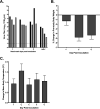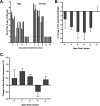Aerosol Transmission from Infected Swine to Ferrets of an H3N2 Virus Collected from an Agricultural Fair and Associated with Human Variant Infections
- PMID: 32522849
- PMCID: PMC7394887
- DOI: 10.1128/JVI.01009-20
Aerosol Transmission from Infected Swine to Ferrets of an H3N2 Virus Collected from an Agricultural Fair and Associated with Human Variant Infections
Abstract
Influenza A viruses (IAV) sporadically transmit from swine to humans, typically associated with agricultural fairs in the United States. A human seasonal H3 virus from the 2010-2011 IAV season was introduced into the U.S. swine population and termed H3.2010.1 to differentiate it from the previous swine H3 virus. This H3N2 lineage became widespread in the U.S. commercial swine population, subsequently spilling over into exhibition swine, and caused a majority of H3N2 variant (H3N2v) cases in humans in 2016 and 2017. A cluster of human H3N2v cases were reported at an agricultural fair in 2017 in Ohio, where 2010.1 H3N2 IAV was concurrently detected in exhibition swine. Genomic analysis showed that the swine and human isolates were nearly identical. In this study, we evaluated the propensity of a 2010.1 H3N2 IAV (A/swine/Ohio/A01354299/2017 [sw/OH/2017]) isolated from a pig in the agricultural fair outbreak to replicate in ferrets and transmit from swine to ferret. sw/OH/2017 displayed robust replication in the ferret respiratory tract, causing slight fever and moderate weight loss. Further, sw/OH/2017 was capable of efficient respiratory droplet transmission from infected pigs to contact ferrets. These findings establish a model for evaluating the propensity of swine IAV to transmit from pig to ferret as a measure of risk to the human population. The identification of higher-risk swine strains can then be targeted for control measures to limit the dissemination at human-swine interfaces to reduce the risk of zoonotic infections and to inform pandemic planning.IMPORTANCE A recently emerged lineage of human-like H3N2 (H3.2010.1) influenza A virus (IAV) from swine has been frequently detected in commercial and exhibition swine in recent years and has been associated with H3N2 variant cases in humans from 2016 and 2017. To demonstrate a model for characterizing the potential for zoonotic transmission associated with swine IAV, we performed an in vivo study of transmission between pigs infected with an H3.2010.1 H3N2 IAV and aerosol contact ferrets. The efficient interspecies transmission demonstrated for the H3.2010.1 IAV in swine emphasizes the need for further characterization of viruses circulating at the swine-human interface for transmission potential prior to human spillover and the development and implementation of more robust vaccines and control strategies to mitigate human exposure to higher-risk swine strains.
Keywords: H3N2; ferrets; human-like; influenza; swine; transmission.
Figures





Similar articles
-
Novel Reassortant Human-Like H3N2 and H3N1 Influenza A Viruses Detected in Pigs Are Virulent and Antigenically Distinct from Swine Viruses Endemic to the United States.J Virol. 2015 Nov;89(22):11213-22. doi: 10.1128/JVI.01675-15. Epub 2015 Aug 26. J Virol. 2015. PMID: 26311895 Free PMC article.
-
Pathogenesis and Transmission of Genetically Diverse Swine-Origin H3N2 Variant Influenza A Viruses from Multiple Lineages Isolated in the United States, 2011-2016.J Virol. 2018 Jul 31;92(16):e00665-18. doi: 10.1128/JVI.00665-18. Print 2018 Aug 15. J Virol. 2018. PMID: 29848587 Free PMC article.
-
Antigenic characterization of H3N2 influenza A viruses from Ohio agricultural fairs.J Virol. 2013 Jul;87(13):7655-67. doi: 10.1128/JVI.00804-13. Epub 2013 May 1. J Virol. 2013. PMID: 23637412 Free PMC article.
-
Genetics, evolution, and the zoonotic capacity of European Swine influenza viruses.Curr Top Microbiol Immunol. 2013;370:29-55. doi: 10.1007/82_2012_267. Curr Top Microbiol Immunol. 2013. PMID: 23011571 Review.
-
Swine Influenza A Viruses and the Tangled Relationship with Humans.Cold Spring Harb Perspect Med. 2021 Mar 1;11(3):a038737. doi: 10.1101/cshperspect.a038737. Cold Spring Harb Perspect Med. 2021. PMID: 31988203 Free PMC article. Review.
Cited by
-
Genetic and molecular characterization of a novel reassortant H3N2 influenza virus from a sick pig in Eastern China in 2019.Vet Res. 2025 Feb 10;56(1):38. doi: 10.1186/s13567-025-01462-7. Vet Res. 2025. PMID: 39930519 Free PMC article.
-
Clinical features of a fatal case of acute encephalitis associated with a novel influenza H3N2 recombinant virus possessing human-origin H7N9 internal genes: a descriptive study.Emerg Microbes Infect. 2025 Dec;14(1):2528536. doi: 10.1080/22221751.2025.2528536. Epub 2025 Jul 17. Emerg Microbes Infect. 2025. PMID: 40671613 Free PMC article.
-
Characterization of an H7N9 Influenza Virus Isolated from Camels in Inner Mongolia, China.Microbiol Spectr. 2023 Feb 21;11(2):e0179822. doi: 10.1128/spectrum.01798-22. Online ahead of print. Microbiol Spectr. 2023. PMID: 36809036 Free PMC article.
-
A direct contact pig influenza challenge model for assessing protective efficacy of monoclonal antibodies.Front Immunol. 2023 Oct 27;14:1229051. doi: 10.3389/fimmu.2023.1229051. eCollection 2023. Front Immunol. 2023. PMID: 37965320 Free PMC article.
-
Vaccine-Associated Enhanced Respiratory Disease following Influenza Virus Infection in Ferrets Recapitulates the Model in Pigs.J Virol. 2022 Mar 9;96(5):e0172521. doi: 10.1128/JVI.01725-21. Epub 2022 Jan 5. J Virol. 2022. PMID: 34985999 Free PMC article.
References
Publication types
MeSH terms
Substances
Grants and funding
LinkOut - more resources
Full Text Sources
Medical

